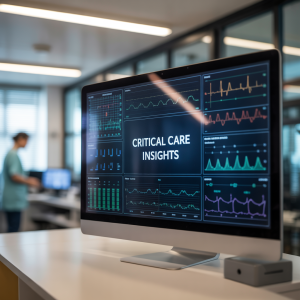Independent Medical Examinations (IMEs) play a critical role in legal and insurance claims. These exams provide an unbiased medical opinion about a person’s health, often in relation to a workplace injury, disability, or accident.
Traditionally, IME providers relied heavily on manual record reviews and physician judgment. But now, artificial intelligence (AI) and wearable devices are stepping in to modernize the process.
In this article, we explore how AI in IME is improving efficiency, accuracy, and fairness—for providers, insurers, and patients alike.

The Role of AI in IME
AI is not replacing IME doctors—it’s equipping them with smarter tools. From cutting down paperwork to catching inconsistencies in IME reports, AI is becoming a powerful assistant in the IME process.
Streamlining Administrative Processes
Administrative tasks can slow down IME delivery. AI speeds things up.
Automated Scheduling and Notifications
AI tools can:
- Match examiners with cases based on availability and specialization
- Automatically send appointment reminders to patients
- Handle rescheduling with minimal human input
This reduces no-shows and saves time for everyone involved.
AI-Based Document Management
IME cases involve stacks of medical records, insurance documents, and legal forms.
AI software can:
- Digitize and organize incoming files
- Tag and categorize documents for easy retrieval
- Flag missing or inconsistent records
Smart Triage of Cases Based on Medical Complexity
Some IMEs are straightforward. Others involve complex histories or multiple injuries. AI can help prioritize:
|
Case Type |
AI Triage Output |
|
Simple sprain |
Low complexity – assign general IME |
|
Multi-surgery back injury |
High complexity – flag for specialist IME |
|
Inconsistent symptoms |
Medium complexity – suggest deeper review |
This makes the process more efficient and ensures the right expertise is applied.
Enhancing Medical Report Accuracy
Reports must be clear, consistent, and evidence-based. AI tools help doctors create stronger, more defensible reports.
Natural Language Processing for Report Drafting
AI writing assistants trained in medical language can:
- Suggest phrasing that’s clear and objective
- Auto-complete common report sections
- Highlight jargon or unclear statements
Doctors still make the final call, but these tools speed up the drafting process.
AI-Powered Consistency Checks in Diagnosis
AI systems can scan reports and compare them to patient records to ensure:
- Diagnoses align with reported symptoms
- Treatment timelines make sense
- Findings don’t contradict earlier notes
This reduces errors and boosts confidence in the report’s conclusions.
Reducing Human Error in Medical Conclusions
Even experienced doctors can miss subtle signs or misinterpret a record. AI helps by:
- Flagging unusual patterns in the data
- Suggesting secondary conditions to consider
- Highlighting outlier values in test results
Think of it as a second pair of eyes—always watching, never tired.
Decision Support for IME Physicians
AI tools also help doctors make better clinical decisions, not just administrative ones.
AI-Assisted Medical Record Review
Instead of reading hundreds of pages, doctors can get:
- Summarized timelines of events
- Highlighted key findings
- Side-by-side comparisons of prior and current reports
This saves time and helps doctors focus on what’s important.
Pattern Recognition for Red Flags
AI can detect red flags like:
- Repeated identical claims across patients
- Reports of pain without corresponding diagnostic support
- Missing follow-ups in treatment histories
These insights help IME physicians dig deeper where needed.
Predictive Analytics for Outcome Forecasting
Some AI platforms now offer predictive modeling. For instance:
|
Input Factors |
AI Prediction Output |
|
Age, injury type, treatment |
Probability of full recovery |
|
Work history, diagnosis |
Risk of permanent disability |
These predictions aren’t definitive—but they provide helpful context for medical opinions.
Integration of Wearable Devices in IMEs
Wearable technology is no longer just for fitness enthusiasts. In the IME world, these devices are giving doctors access to real-world data—not just what patients report in a clinic.
From smartwatches to motion trackers, wearable devices offer a new level of objectivity in evaluating a person’s health status.
Continuous Patient Monitoring
With wearable tech, IME evaluations aren’t limited to what happens during a 30-minute exam. These devices can monitor patients throughout their daily lives.
Collection of Real-Time Data
Wearables can track:
- Heart rate
- Sleep patterns
- Steps and activity levels
- Range of motion
- Gait and balance
This data provides a continuous picture of a patient’s condition—rather than relying solely on what they say they feel during the exam.
Improved Objectivity in Pain and Mobility Claims
It’s difficult to verify subjective claims like “I’m always in pain” or “I can’t walk far.” But wearables offer real-time proof:
|
Claim |
Wearable Insight |
|
“I can’t walk more than 5 minutes” |
Shows regular 20-minute walks |
|
“I’m always resting” |
Tracks high levels of daily activity |
|
“I never sleep due to pain” |
Logs 7+ hours of restful sleep |
This doesn’t mean patients are lying—but it helps IME doctors identify inconsistencies and ask better follow-up questions.
AI-Powered Analysis of Wearable Data
Raw data alone isn’t enough. That’s where AI steps in—to make sense of the numbers.
Detecting Anomalies and Inconsistencies
AI tools can sift through weeks of data in seconds to spot patterns like:
- Sudden drops in activity
- Recovery plateaus
- Signs of symptom exaggeration or underreporting
This helps create a fuller, more nuanced picture of a patient’s recovery.
Supporting Return-to-Work Assessments
IME physicians often have to answer: Is this person ready to return to work?
With wearable data, they can see:
- How much physical strain the person is tolerating
- Whether their activity level is trending upward
- If there are warning signs of re-injury
All of this can guide more informed decisions—and potentially reduce disputes or appeals.

Benefits of AI in IME
Bringing AI into the IME process isn’t just about tech for tech’s sake. It delivers real, practical benefits to everyone involved—doctors, insurers, attorneys, and patients.
Let’s break it down.
For IME Providers
IME physicians and clinics feel the pressure to deliver high-quality reports, fast. AI helps ease that burden.
Faster Case Turnaround
AI cuts down time spent on:
- Reviewing bulky medical records
- Drafting repetitive sections in reports
- Scheduling and paperwork
That means doctors can focus on what matters most—clinical judgment.
Improved Report Quality
With AI-assisted tools, reports become:
- More consistent
- Better organized
- Easier to defend in court or arbitration
This raises the overall credibility of the IME provider.
For Insurers and Legal Professionals
Claims adjusters and attorneys rely on IMEs to be accurate and objective. AI makes this easier to trust.
Clearer Evidence Base
AI-supported reports are often:
- Backed by wearables or data summaries
- Transparent in how conclusions were reached
- Supported by AI-flagged trends or inconsistencies
That creates a stronger foundation for decisions.
Enhanced Fraud Detection
Unfortunately, not all claims are honest. AI can:
- Spot red flags in patient history
- Identify unusual recovery patterns
- Compare claims across similar cases for anomalies
This doesn’t replace human investigation—but it’s a helpful starting point.
|
Claim Element |
AI Support Function |
|
Prior injuries undisclosed |
Cross-checks records automatically |
|
Symptom exaggeration |
Analyzes wearable and movement data |
|
Conflicting timelines |
Flags inconsistencies in notes |
For Patients
AI can also improve the IME experience for patients—especially those who feel the process is stacked against them.
Fairer Evaluations
Wearables and data-driven tools reduce bias. They:
- Provide evidence beyond verbal testimony
- Show how a person functions day-to-day
- Help IME doctors see the full picture
This leads to more balanced reports.
Less Repetition of Exams
When AI tools efficiently gather and organize data, doctors may not need to:
- Call for additional testing
- Schedule multiple appointments
- Re-review stacks of paperwork
Patients benefit from quicker resolutions and fewer hoops to jump through.
Limitations and Ethical Considerations
While AI and wearable tech are transforming IMEs, they’re not perfect. There are limits to what these tools can do—and important IME ethics to consider.
Doctors, insurers, and legal professionals must use these technologies thoughtfully to avoid problems down the line.
Data Privacy and Security
With great data comes great responsibility. When you’re collecting sensitive health information, protecting it is non-negotiable.
Compliance with HIPAA and Related Laws
IME providers must ensure that all AI systems and wearable devices follow strict privacy standards.
Key considerations include:
- Encryption: Data must be secured both in storage and during transfer.
- Access control: Only authorized personnel should view medical data.
- Transparency: Patients should know what’s being collected and why.
|
Data Source |
Privacy Risk |
Protection Measures |
|
Wearable devices |
Continuous tracking |
Device-level encryption |
|
AI cloud platforms |
Centralized data access |
Role-based user restrictions |
|
Automated summaries |
Misuse or leaks |
Secure storage, audit trails |
Even one breach can damage trust—and potentially lead to legal consequences.
Risk of Over-Reliance on AI
AI is a helpful tool, not a replacement for clinical expertise. Overusing it can lead to poor decisions.
Importance of Physician Oversight
IME physicians should always:
- Review AI suggestions with a critical eye
- Use AI as support, not a crutch
- Provide clear reasoning in reports, even when AI is involved
Patients and legal professionals need to know a human expert is still in charge.
Avoiding Bias in AI Algorithms
AI is only as good as the data it’s trained on. If that data contains bias, the AI might:
- Undervalue certain symptoms
- Misinterpret patterns across demographics
- Flag false positives for fraud or exaggeration
To reduce this risk:
- Algorithms must be tested across diverse populations
- Systems should allow human override of questionable AI flags
- IME providers should partner with ethical tech vendors
Bias isn’t always obvious—but it can have serious consequences for people already going through stressful claims.
The Future of IME with AI
We’re only scratching the surface of what AI and wearables can do in the IME space. As technology continues to evolve, we can expect even more innovation—and disruption.
Trends to Watch
These developments are already on the horizon:
Integration with Telemedicine
AI and wearables are a perfect match for virtual IMEs. Together, they make remote evaluations more robust.
For example:
- Patients wear a device at home to track movement before their exam
- AI organizes key data for the doctor in advance
- A telemedicine visit confirms or clarifies what the data shows
This reduces travel, speeds up care, and allows broader access to specialists.
Cross-Platform Interoperability
Today, medical data lives in silos—different systems that don’t talk to each other.
In the future, we’ll see:
- AI systems pulling records from multiple sources
- Wearables syncing directly with IME reporting platforms
- Seamless sharing of insights across providers and insurers
This kind of connection could make IMEs faster, fairer, and more data-rich.
Preparing for Change
To fully benefit from these advances, IME stakeholders need to take active steps.
Training for IME Physicians
Doctors need training—not just in using AI, but in understanding how it works.
Training should cover:
- Basics of how AI algorithms are built and refined
- How to interpret AI-suggested patterns or inconsistencies
- When to trust the AI—and when to override it
This builds confidence and ensures ethical, responsible use.
Adoption Challenges and Solutions
Of course, change isn’t always easy. Common roadblocks include:
|
Challenge |
Suggested Solution |
|
Cost of new systems |
Start small—pilot programs with key teams |
|
Resistance from staff |
Offer training, show time-saving benefits |
|
Technical integration issues |
Work with vendors who support customization |
With careful planning, the shift to AI-supported IMEs doesn’t have to be disruptive—it can be empowering.
Breaking It All Down
The world of Independent Medical Examinations is changing fast. Thanks to AI and wearable devices, IMEs are becoming:
- Faster
- More accurate
- Less subjective
For doctors, these tools offer relief from paperwork. For insurers and attorneys, they offer clearer evidence. And for patients, they offer a fairer, more transparent process.
Still, technology is not a cure-all. Human expertise, empathy, and oversight remain essential. But when used wisely, these emerging technologies can help everyone involved in an IME get closer to the truth.
The future is here—and it’s smarter, faster, and more connected.
Frequently Asked Questions
Can AI be used to generate final IME conclusions?
No, AI should not be used to replace clinical judgment. It can assist by highlighting patterns or inconsistencies, but a licensed medical professional must make the final decision.
Are AI-assisted IMEs accepted in court?
Courts generally accept IMEs supported by AI as long as the conclusions are still made by a qualified human expert. However, the credibility of AI-supported evidence can vary by jurisdiction and case context.
Do wearable devices work for all types of injuries?
Wearables are most effective for tracking physical activity and mobility-related conditions. They are less useful for conditions that don’t manifest in measurable movement or biometric data, such as psychological injuries.
How is wearable data validated in an IME?
The data is often cross-checked with known baselines, clinical records, and symptom reports. AI helps flag discrepancies, but it’s the physician’s role to determine how reliable the wearable data is in context.
Who owns the data collected from wearables in an IME?
Ownership typically depends on the agreement between the patient and the provider. Patients should be informed up front how their data will be used, stored, and shared.
Can patients refuse to wear monitoring devices for an IME?
Yes, patients can decline, but it may affect how much objective data is available to support or dispute their claims. Physicians must note any refusals in the report.
Are there risks of AI making biased recommendations?
Yes. If an AI system is trained on biased data, it can produce biased outcomes. It’s essential that AI tools used in IMEs are audited regularly and reviewed by humans.
Do IME doctors need technical expertise to use AI tools?
Not in-depth. Most platforms are designed to be user-friendly. However, doctors do benefit from basic training to understand how to interpret and question AI-supported insights.
How do IME clinics choose the right AI or wearable platform?
Factors include ease of integration, cost, data security, technical support, and whether the tool is built specifically for medical-legal contexts. Piloting with a small team first is often recommended.
Can AI help detect malingering?
It can assist by flagging patterns that don’t align with known medical behavior. But AI cannot make accusations. It’s up to the physician to investigate and decide how to proceed.
Offsite Resources
- American Medical Association (AMA) – The AMA regularly discusses developments in digital health, medical ethics, and the responsible use of AI in clinical settings.
https://www.ama-assn.org - NIH National Library of Medicine – A leading source for research on AI applications in healthcare, including studies on wearable devices and medical assessments.
https://www.nlm.nih.gov - HealthIT.gov – Run by the Office of the National Coordinator for Health Information Technology, this site explores how technology, including AI, is transforming U.S. healthcare.
https://www.healthit.gov - IEEE Standards Association – Offers insights into how AI and wearable technologies are being standardized in healthcare, supporting ethical and consistent usage.
https://standards.ieee.org - MedTech Europe – A strong resource for developments in medical technology across Europe, including AI and wearables in diagnostic and rehabilitation settings.
https://www.medtecheurope.org - The Brookings Institution – Artificial Intelligence and Emerging Technology Initiative – This think tank provides thought leadership and policy analysis on how AI affects industries including healthcare and law.
https://www.brookings.edu - World Health Organization (WHO) – WHO’s digital health hub covers global perspectives on how technologies like AI and wearables are impacting patient care and health systems.
https://www.who.int

What’s Next?
If you’re looking for trusted, efficient, and expertly supported Independent Medical Examinations, MLPIME.com is here to help. Whether you’re an attorney, insurer, or healthcare professional, our nationwide network of IME physicians is backed by smart technology and a dedicated team that understands the demands of your case. Ready to get started or have questions? Call us today at 1-833-465-7463—our friendly staff is standing by to assist you.

